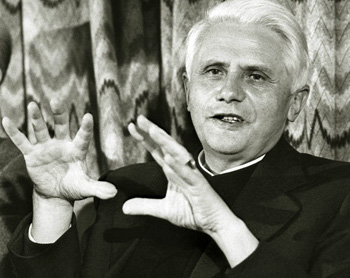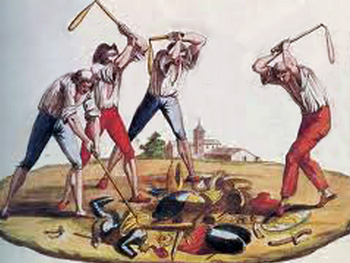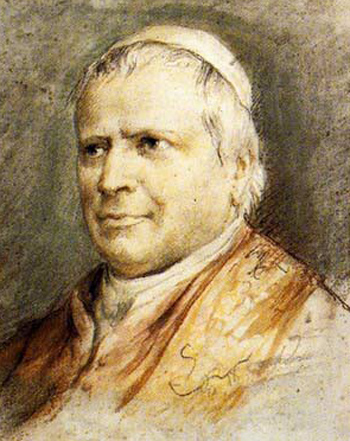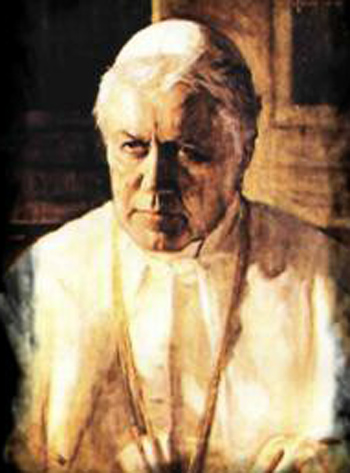Consequences of Vatican II
 |
 |
 |
 |
 |
 |
 |
The Great Moral Flaw in Vatican II - Part II
Vatican II Clashed with the Previous Popes
In the last article, we saw Card. Joseph Ratzinger stating that the Second Vatican Council, especially in its Constitution Gaudium et spes, represented a great change in the position of the Church regarding the modern world. He went as far as to affirm Gaudium et spes was a counter-syllabus.
He also declared that the Church “corrected” her previous relationship with the world and replaced it with one favorable to the principles of the French Revolution. Was his acknowledgement an approval of the Council or a rejection of it?
One might assume that when Card. Ratzinger wrote that, at the time of the Vatican II, “there was still no basic statement of the relationship that should exist between the Church and the [post-1789] world,” he meant that there was no such basic statement except those of Popes:

 In other words, at the time of Vatican II there was indeed a basic statement of the relationship that should exist between the Church and the post-1789 world.
In other words, at the time of Vatican II there was indeed a basic statement of the relationship that should exist between the Church and the post-1789 world.
Further, this position was reflected in several basic statements over several post-1789 generations and several post-1789 papacies, which, with remarkable internal consistency, bespoke a “relationship” of opposition between the Church and the post-1789 “modernist” world. However, the overwhelming majority of the participants in the Vatican II apparently wanted to disagree with these statements.
Card. Ratzinger seemed to admit candidly exactly that when he wrote:
“The text [of the Vatican II documents, especially Gaudium et spes] serves as a counter-syllabus and, as such, represents, on the part of the Church, an attempt at an official reconciliation with the new era inaugurated in 1789. (2)
Vatican II, frontally opposed to the teaching of previous Popes
At first glance, these statements may not seem to be “astonishing.” Card. Ratzinger was, after all, only stating the obvious, wasn’t he? He was only being candid. His statement was actually quite unremarkable. It is well known and widely popularly believed that reconciling the Church with the modern world was the whole point of Vatican II - wasn’t it?

 What perhaps gnaws uncomfortably at the intellect in those statements is the fact that Card. Ratzinger was suggesting that the main goal of the Council was to set up a
counter-syllabus, an opposition document, to the consistent and uniform teachings of six of the predecessor Popes.
What perhaps gnaws uncomfortably at the intellect in those statements is the fact that Card. Ratzinger was suggesting that the main goal of the Council was to set up a
counter-syllabus, an opposition document, to the consistent and uniform teachings of six of the predecessor Popes.
To place Card. Ratzinger’s statements in the sharpest possible context, one must go back to those events that occurred more than a half century before Vatican II, to the era in which the Church was consistently articulating its statements of opposition towards those tenets of Liberalism and Modernism that came to characterize the post-1789 age.
On July 3, in the year 1907, Pope St. Pius X issued a decree called Lamentabili sane, listing and condemning the errors of the heresy of Modernism. Two months later in that same year of 1907, on September 8, the same Pope issued the Encyclical Pascendi Dominici gregis, a more lengthy explanatory discussion and condemnation of the heresy of Modernism, referring to it as the “synthesis of all heresies”. (3)
Three years later, on September 1, 1910, Pius X issued a motu proprio entitled Sacrorum Antistitum in which he mandated that the Oath against Modernism (welcomed at the time by genuine Catholics and dreaded by the dissenting modernist Catholics of the day) be taken by all Catholic clergy before being ordained to the sub-diaconate on their way to the priesthood.
The text of the Oath, mentioning and condemning the tenets and tendencies of the heresy, was prescribed in the motu proprio.(4) It is of great importance to note that St. Pius X’s Oath against Modernism mandate was not rescinded until 1967, (5) more than a year after the closing of the Vatican II. (6) Thus, every Catholic priest ordained between the years 1910 and 1967 was obliged to take the Oath against Modernism as prescribed by Pope Pius X.
Recall Card. Ratzinger’s words: “The position taken in the Syllabus [of Pius IX] was adopted and continued in Pius X’s struggle against Modernism,” (7) and “the text as a whole ... is a revision of the Syllabus of Pius IX, a kind of counter-syllabus.” (8) The texts to which he refers here are Gaudium et spes, Dignitatis humanae (on religious freedom), and Nostra aetate (on the relation of the Church to non-Christian religions).
Opposed to the Oath against Modernism they had taken…
The implications are startling. Every single Bishop, Archbishop and Cardinal who participated in the Second Vatican Council and every single Vatican II perito (expert advisor) who was also a priest, without exception, had taken the Oath against Modernism mandated for all Catholic clergy by St. Pius X in 1910 and not rescinded until 1967.
Every single participant in Vatican II was under an oath-bound obligation to God Almighty, “with due reverence to submit and adhere with his whole heart to the condemnations, declarations, and all the prescripts contained in the Encyclical Pascendi and in the decree Lamentabili [the encyclical and decree that condemned Modernism as a heresy].” (9)
Seen in this light, Card. Ratzinger’s statements are truly astonishing. How could the participants in the Vatican II set out intentionally to “correct” or to set up a “counter-syllabus” to precisely that which they all, without exception, had sworn “with [their] whole heart” to “submit and adhere”? How can one who is oath-bound to support the papal condemnations of Modernism act to correct or “counter” those very condemnations?
What are we to believe? It is an important topic that still needs to be addressed. The next article will undertake this task.
Continued
Raymond B. Marcin is Professor of Law Emeritus
Columbus School of Law
The Catholic University of America
Washington, DC

He also declared that the Church “corrected” her previous relationship with the world and replaced it with one favorable to the principles of the French Revolution. Was his acknowledgement an approval of the Council or a rejection of it?
One might assume that when Card. Ratzinger wrote that, at the time of the Vatican II, “there was still no basic statement of the relationship that should exist between the Church and the [post-1789] world,” he meant that there was no such basic statement except those of Popes:

Card. Ratzinger pretended there were no pre-conciliar statements on the Church and the modern world
- Gregory XVI: Mirari vos [on Liberalism], 1832;
- Pius IX: Quanta cura [on current errors], 1864, and Syllabus of Errors, 1864;
- Leo XIII: Diuturnum illud [on government authority], 1881; Humanum genus [on Freemasonry and Naturalism], 1884; Libertas praestantissimum [on the nature of true liberty], 1888; Rerum novarum [on the condition of the working classes], 1891; Graves de communi Re [on Christian Democracy], 1901;
- St. Pius X: Lamentabili sane [syllabus condemning the errors of the modernists,} 1907; Pascendi Dominici gregis [on Modernism], 1907; on the “Sillon”, 1910; Sacrorum Antistitum [the Oath against Modernism], 1910;
- Pius XI: Quas primas [on the feast of Christ the King] 1925; Mortalium animos [on fostering true religious unity], 1928; Divini Redemptoris [on atheistic Communism], 1937;
- Pope Pius XII: Humani generis [on certain false opinions which threaten to undermine the foundations of Catholic doctrine], 1950. (1)

French revolutionaries destroy symbols of the Church and monarchy, showing their hatred for all authority
Further, this position was reflected in several basic statements over several post-1789 generations and several post-1789 papacies, which, with remarkable internal consistency, bespoke a “relationship” of opposition between the Church and the post-1789 “modernist” world. However, the overwhelming majority of the participants in the Vatican II apparently wanted to disagree with these statements.
Card. Ratzinger seemed to admit candidly exactly that when he wrote:
“The text [of the Vatican II documents, especially Gaudium et spes] serves as a counter-syllabus and, as such, represents, on the part of the Church, an attempt at an official reconciliation with the new era inaugurated in 1789. (2)
Vatican II, frontally opposed to the teaching of previous Popes
At first glance, these statements may not seem to be “astonishing.” Card. Ratzinger was, after all, only stating the obvious, wasn’t he? He was only being candid. His statement was actually quite unremarkable. It is well known and widely popularly believed that reconciling the Church with the modern world was the whole point of Vatican II - wasn’t it?

In the Council the Bishops opposed the Catholic teaching of Pius IX, Pius X and four other Popes

To place Card. Ratzinger’s statements in the sharpest possible context, one must go back to those events that occurred more than a half century before Vatican II, to the era in which the Church was consistently articulating its statements of opposition towards those tenets of Liberalism and Modernism that came to characterize the post-1789 age.
On July 3, in the year 1907, Pope St. Pius X issued a decree called Lamentabili sane, listing and condemning the errors of the heresy of Modernism. Two months later in that same year of 1907, on September 8, the same Pope issued the Encyclical Pascendi Dominici gregis, a more lengthy explanatory discussion and condemnation of the heresy of Modernism, referring to it as the “synthesis of all heresies”. (3)
Three years later, on September 1, 1910, Pius X issued a motu proprio entitled Sacrorum Antistitum in which he mandated that the Oath against Modernism (welcomed at the time by genuine Catholics and dreaded by the dissenting modernist Catholics of the day) be taken by all Catholic clergy before being ordained to the sub-diaconate on their way to the priesthood.
The text of the Oath, mentioning and condemning the tenets and tendencies of the heresy, was prescribed in the motu proprio.(4) It is of great importance to note that St. Pius X’s Oath against Modernism mandate was not rescinded until 1967, (5) more than a year after the closing of the Vatican II. (6) Thus, every Catholic priest ordained between the years 1910 and 1967 was obliged to take the Oath against Modernism as prescribed by Pope Pius X.
Recall Card. Ratzinger’s words: “The position taken in the Syllabus [of Pius IX] was adopted and continued in Pius X’s struggle against Modernism,” (7) and “the text as a whole ... is a revision of the Syllabus of Pius IX, a kind of counter-syllabus.” (8) The texts to which he refers here are Gaudium et spes, Dignitatis humanae (on religious freedom), and Nostra aetate (on the relation of the Church to non-Christian religions).
Opposed to the Oath against Modernism they had taken…
The implications are startling. Every single Bishop, Archbishop and Cardinal who participated in the Second Vatican Council and every single Vatican II perito (expert advisor) who was also a priest, without exception, had taken the Oath against Modernism mandated for all Catholic clergy by St. Pius X in 1910 and not rescinded until 1967.
Every single participant in Vatican II was under an oath-bound obligation to God Almighty, “with due reverence to submit and adhere with his whole heart to the condemnations, declarations, and all the prescripts contained in the Encyclical Pascendi and in the decree Lamentabili [the encyclical and decree that condemned Modernism as a heresy].” (9)
Seen in this light, Card. Ratzinger’s statements are truly astonishing. How could the participants in the Vatican II set out intentionally to “correct” or to set up a “counter-syllabus” to precisely that which they all, without exception, had sworn “with [their] whole heart” to “submit and adhere”? How can one who is oath-bound to support the papal condemnations of Modernism act to correct or “counter” those very condemnations?
What are we to believe? It is an important topic that still needs to be addressed. The next article will undertake this task.
Continued
Columbus School of Law
The Catholic University of America
Washington, DC
- The texts of all these documents are reproduced in The Popes against Modern Errors (ed. Anthony J. Mioni, TAN Books and Publishers, Inc., 1999).
- Joseph Cardinal Ratzinger, Principles of Catholic Theology: Building Stones for a Fundamental Theology, tr. Sister Mary Frances McCarthy (San Francisco: Ignatius Press 1987), 382 (emphasis added).
- Pope St. Pius X, Pascendi Dominici Gregis (On Modernism), 1907, para. 39 (emphasis added). For an excellent discussion of the heresy of Modernism in general and of Pascendi Dominici Gregis in particular, see Michael Davies, Partisans of Error: St. Pius X Against the Modernists (Neumann Press, 1983).
- Pope Saint Pius X, (The Oath Against Modernism).
- In 1918, the Sacred Congregation of the Holy Office declared that the prescriptions of the Oath against Modernism must remain in full force until the Holy See declared otherwise. See The Code of Canon Law: A Text and Commentary (eds. James A. Coriden, Thomas J. Green & Donald E. Heintschel, Paulist Press 1985), p. 585. The mandate was rescinded by a decree of the Congregation for the Doctrine of the Faith in July of 1967. See “Oath against Modernism” in The Harper Collins Encyclopedia of Catholicism, p. 926.
- Pope Paul VI’s discourse closing the Second Vatican Council was delivered on December 7, 1965.
- Ratzinger, Principles of Catholic Theology, p. 381 (emphasis added).
- Ibid.
- Pius X, Sacrorem Antistitum (The Oath Against Modernism).

Posted March 14, 2014














